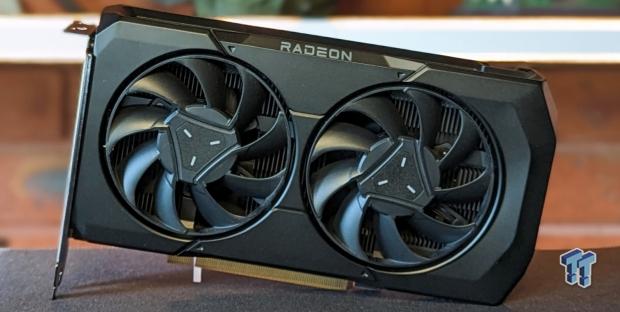
The Bottom Line
Pros
- + A small, compact 1080p GPU
- + Trumps the RTX 3060 in most games we benchmarked
- + The price is right
- + Solid build quality in the reference design
Cons
- - Significant performance drop-off at 1440p
- - Ray-tracing performance is a let-down
- - The reference model is noisier than expected
Should you buy it?
AvoidConsiderShortlistBuyIntroduction
It's GPU launch week, apparently, and with NVIDIA launching the GeForce RTX 4060 Ti, we're finally getting the next entry in the RDNA 3-powered Radeon RX 7000 line-up with the arrival of the Radeon RX 7600 from AMD. The first new addition since the series debuted with the flagship Radeon RX 7900 XTX and Radeon RX 7900 XT combo last year. And with that, you're looking at the opposite end of the RDNA 3 spectrum, with the Radeon RX 7600 representing an entry-level mainstream 1080p option for the very affordable 'starting from' price point of USD 269. So yeah, we'll have to wait a bit longer to see what the Radeon RX 7700 and RX 7800 are like.
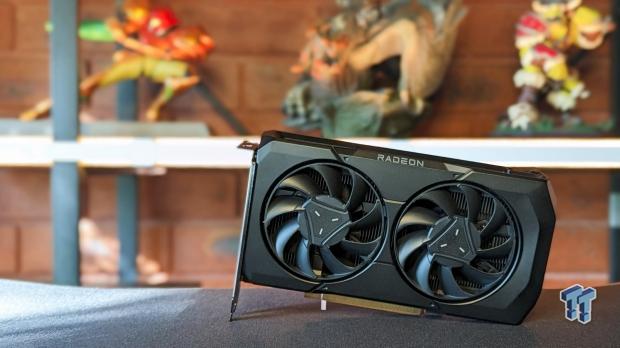
The entry-level price also means that the Radeon RX 7600 isn't directly competing with the GeForce RTX 4060 Ti, its closest competitor would be the GeForce RTX 4060, launching in July for USD 299. Or the current GeForce RTX 3060, which carries a price point of USD 329. Or even Intel's Arc A750, which we recently reviewed. When you reach the mainstream GPU bracket, price and relative performance matter; starting from USD 269, the Radeon RX 7600 is affordable and then some. So then, how does RDNA 3 scale on the low-end?
With 1080p gaming and GPUs like the GeForce GTX 1060, RTX 2060, and RTX 3060 making up the most popular graphics cards out there (according to the latest Steam Hardware Survey), it's no surprise that AMD is positioning the Radeon RX 7600 as a 1080p focused upgrade for these older graphics cards. And on that front, it delivers with a few caveats and quirks.
Even though ray tracing is listed as one of its features, actual performance is inconsistent, so we decided to drop our Cyberpunk 2077 RT benchmark - bringing the overall in-game benchmark count to 14 from 15. Using the RT Ultra setting (AMD recommends RT Low), it kept hanging.
Regarding where the overall performance sits, you're looking at better than GeForce RTX 3060 performance at 1080p, with a lower price point. And although in-game performance isn't in the same range as the recently released GeForce RTX 4060 Ti (or even the RTX 3060 Ti), the USD 269 price makes the Radeon RX 7600 an entry-level option to consider even if it isn't as exciting as a high-end release.

The RDNA 3 Generation
"The world's first chiplet gaming GPU" is how AMD described its new RDNA 3-based GPUs when it lifted the lid on the new Radeon RX 7000 Series. In layperson's terms, the GPU chip isn't just one big square or die anymore, with billions of transistors all arranged in a single layout. Like with its Ryzen CPU range, which embraced chiplet design to great effect (look at how Ryzen has grown in popularity over the years), bringing this design philosophy into the GPU space felt like the natural evolution for AMD's Radeon brand.
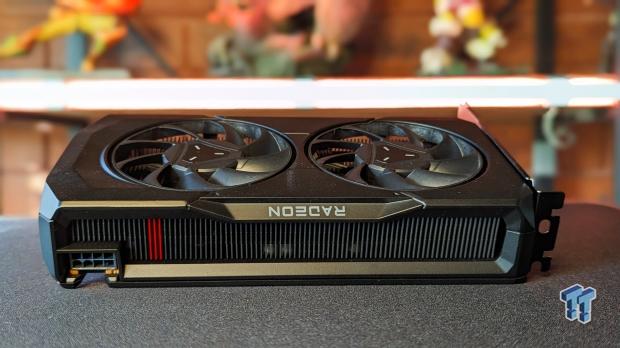
For RDNA 3, what was once a single Graphics Compute Die (GCD) has now split into a GCD plus a Memory Cache Die (MCD). The GCD still makes up most of the hardware grunt and uses the newer 5nm process technology - a step up from RDNA 2's 7nm process. Interestingly, the MCD uses 6nm process technology, which allows AMD to keep costs down as the complexity and cost of manufacturing high-end tech continue to rise.
And to mitigate any performance impact that could arise from going the chiplet route, AMD has also managed to include the "fastest chiplet interconnect in the world," with speeds of 5.3 TB/s. That said, regarding the Radeon RX 7600 and more entry-level models, the design follows a more traditional single-chip setup using 6nm process technology to help keep costs down. But with the same RDNA 3 architecture.
AMD's RDNA 3 architecture features second-generation AMD Infinity Cache, another CPU-like feature designed to boost performance in 1440p and 4K gaming - a "bandwidth amplifier" that sits alongside the GDDR6 memory interface. It helps alleviate the need for more expensive and power-hungry memory buses and is one of those forward-thinking designs we love seeing.
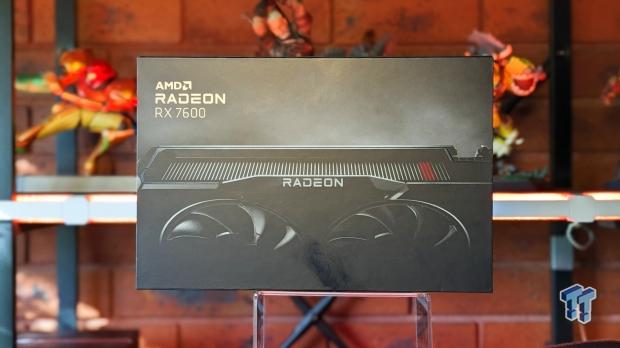
RDNA 3 represents a significant leap forward for AMD regarding ray-tracing and AI accelerators too. RDNA 3 GPUs feature the second generation of dedicated RT hardware and new hardware-based AI acceleration. Real-time ray tracing is hardware intensive; this is one area many were looking for AMD to improve compared to RDNA 2. Which, admittedly, was the company's first attempt at hardware-based ray tracing.
RDNA 3 GPUs are the first graphics cards supporting the new DisplayPort 2.1 spec. The latest DisplayPort interface supports up to 4K 480Hz and even 8K 165Hz, which makes it more of a future-proofing measure than something applicable today. But the real benefit comes with 12-bit HDR support and full Rec2020 coverage for improved color accuracy and detail.
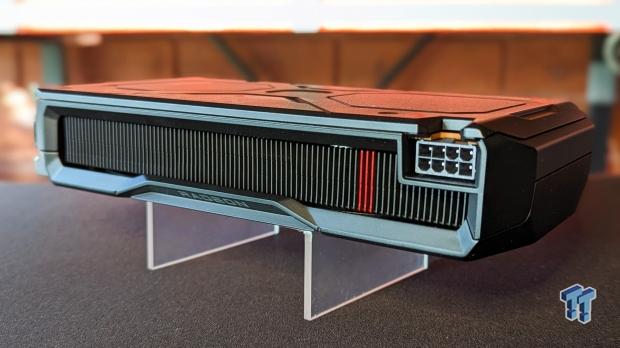
RDNA 3 also introduces hardware-based AV1 encoding to step up its video game for content creators, which means better quality video using the same bitrate. Very cool. For gamers, the introduction of AMD FSR 2 rendering is fully supported here and helps improve performance in intensive games. FSR 2 support might not be as widespread as NVIDIA DLSS, but its addition to games like Cyberpunk 2077 and Star Wars Jedi: Survivor is a great sign. Plus, as the tech is fully supported on Xbox Series X|S and PlayStation 5 (with both consoles using AMD graphics hardware), in-game FSR support should grow as time passes.
AMD has yet to formally showcase or reveal what its DLSS 3-like FSR 3 frame generation technology will look like or whether it will be exclusive to RDNA 3-based hardware, so we'll have to wait and see on that front. Ultimately, RDNA 3 is an impressive leap forward for AMD, bringing massive changes to the underlying hardware while delivering a sizable performance leap over the previous RDNA 2 generation.
Specs and Test System
Specifications
Here we can see how the specs and hardware stack up for the AMD Radeon RX 7600 compared to the previous generation's AMD Radeon RX 6600.
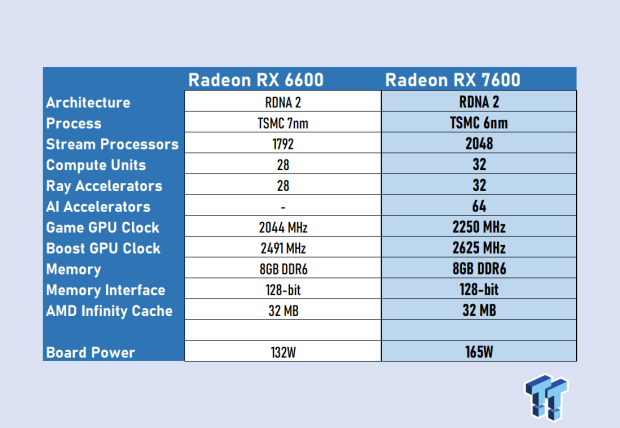
Unlike the Radeon RX 7900 XTX and XT models, which are built using a multi-chip design, the Radeon RX 7600 follows a more traditional route by using a single and small chip built using 6nm process technology. The reason for using 6nm versus 5nm probably comes down to cost, and one of the reasons AMD can release the Radeon RX 7600 with pricing starting from USD 269. Also, the lack of the 'XT' branding makes this an entry-level GPU where we could see something like a 7600 XT or 7650 XT in the future.
And with that, the direct gen-on-gen comparison would be with the Radeon RX 6600, and on that front, the new Radeon RX 7600 sees a 14.3% increase in the Stream Processor and Compute Unit counts. Plus, a modest 5.4% bump to the boost GPU clock speeds. It retains the same 8GB of GDDR6 memory configuration, albeit with a bump to overall memory speed - rising to 18 Gbps. Although the 128-bit memory bus interface sits on the low-end, adding 32 MB of second-generation AMD Infinity Cache helps increase the effective memory bandwidth to roughly 476.9 GB/s.
Interestingly the die size for the Radeon RX 7600 has shrunk from 237mm in the Radeon RX 6600 to 204mm here - but even so, the overall power draw of 165W is higher than the Radeon RX 6600's 132W. Like with the high-end cards for the Radeon RX 7000 Series, power efficiency isn't on par with what we've seen from NVIDIA, where the 165W here is equivalent to the RTX 4060 Ti 16GB model. That's not to say that these two cards are like-for-like; it's just that RDNA 3's efficiency gains have fallen short - even for the entry-level Radeon RX 7600.
- GPU: AMD Radeon RX 7600
- Model: AMD Radeon RX 7600 Reference
- Interface: PCI Express 4.0
- Stream Processors: 2048
- Clock Speeds: Up to 2625 MHz (Boost Clock)/Up to 2250 MHz (Game Clock)
- Memory: 8GB GDDR6
- Memory Speed: 18 Gbps
- Memory Interface: 128-bit
- Display Connections: 1 x HDMI 2.1, 3 x DisplayPort 2.1
- Power Connectors: 1 x 8-pin
- Recommended PSU: 550W
- What's in the Box: AMD Radeon RX 7600 Reference, Welcome Card, Safety Card
Kosta's Test System
- Motherboard: MSI MPG X670E Carbon Wi-Fi
- CPU: AMD Ryzen 9 7900X
- Cooler: Corsair iCUE H100i RGB PRO XT Liquid CPU Cooler
- RAM: 64GB (2x32GB) Corsair DOMINATOR PLATINUM RGB DDR5 DRAM 5200MHz
- SSD: Sabrent Rocket 4 Plus-G M.2 PCIe Gen 4 SSD 4TB, Sabrent Rocket 4 Plus M.2 PCIe Gen 4 SSD 8TB
- Power Supply: Thermaltake Toughpower GF1 850W
- Case: Thermaltake Core P3 Tempered Glass Snow
- OS: Microsoft Windows 11 Pro 64-bit
Physical Design and Cooling
Okay, so AMD's reference Radeon RX 7600 is tiny - it might just be the smallest GPU I've seen in years. With its two-slot thickness, a length of around 202mm (20cm), and a height of only 100mm (10cm), the Radeon RX 7600 reference design is small and compact.
AMD's reference design follows what we saw with the Radeon RX 7900 combo, albeit in Honey, I Shrunk the GPU form. The build quality here is impressive, with a full metal backplate and housing, funky angular flourishes, and minimal use of branding outside of the word Radeon.
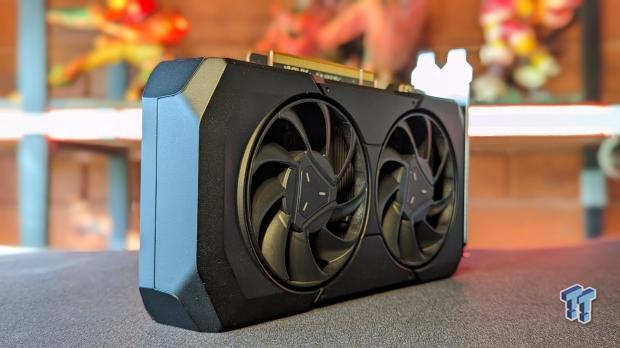
Even though it's small, with all the metal build, including the heatsink, the reference Radeon RX 7600 is a pretty solid and weighty little GPU. The good news is that it can fit just about any case, including small form factor ones with limited space for graphics cards.
Cooling-wise, you've got the standard two-fan setup with the heatsink taking up the total size of the PCB, which runs the entire length of the Radeon RX 7600. As for the effectiveness, that's a little tricky to answer as AMD's review guide notes that temperature measurements are based on the junction temperature of the graphics card - otherwise known as the 'hotspot.' AMD notes that operating at 105 degrees Celsius at the hotspot is "typical" for the Radeon RX 7600 - though we didn't see this climb higher than 85 degrees in our testing.
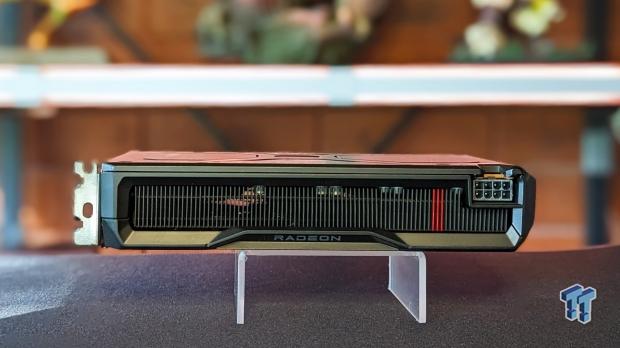
One area of potential concern with the Radeon RX 7600 is that we noticed quite a bit of coil whine when benchmarking - a lot more than other GPUs we've recently tested. Swapping out the reference model for Sapphire Pulse's OC Radeon RX 7600 showed that the issue looks limited to the reference design. Sapphire's custom Radeon RX 7600 didn't have a noticeable coil whine.
Benchmarks - 14 Game Averages
The Games and Tests
In 2023 PC gaming is a complicated and varied space, from indie games to major blockbuster releases and titles that push hardware and technology to their limit with the adoption of effects like real-time ray-tracing.
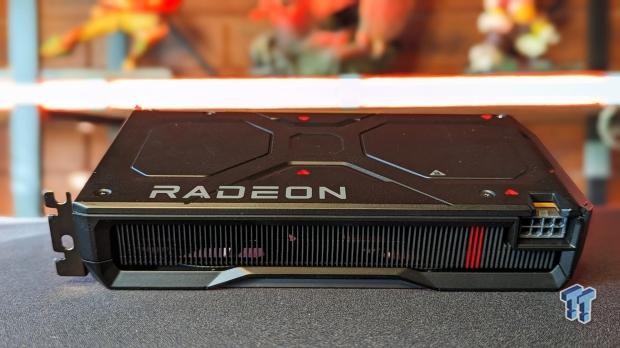
This is all a way of saying that the 14 in-game benchmarks we've chosen (and run at 1080p and 1440p) represent a wide range of styles, not only in terms of genres, like first-person shooters and racing games but also in the API technology (DirectX 11, 12) and cutting-edge features like ray tracing and upscaling technology.
Results include DLSS and FSR 2, where possible, as both technologies are the sorts of things, especially in 1440p and 4K, which you'd turn on. Six of the 15 game benchmarks also feature ray tracing. Also, each title is set to ultra-equivalent quality settings to push GPU hardware and minimize CPU bottlenecks at higher resolutions.
Also, it's just fun to max out a game's visual settings and see the results. Here's the breakdown of games, graphics settings, and what's being tested.
And with 14 games, a special shoutout goes to Sabrent for providing us with the storage to ensure we can keep everything installed - and then some - with both the Sabrent Rocket 4 Plus-G M.2 PCIe Gen 4 SSD 4TB and Sabrent Rocket 4 Plus Plus-G M.2 PCIe Gen 4 SSD 8TB offering exceptional performance, capacity, and reliability.
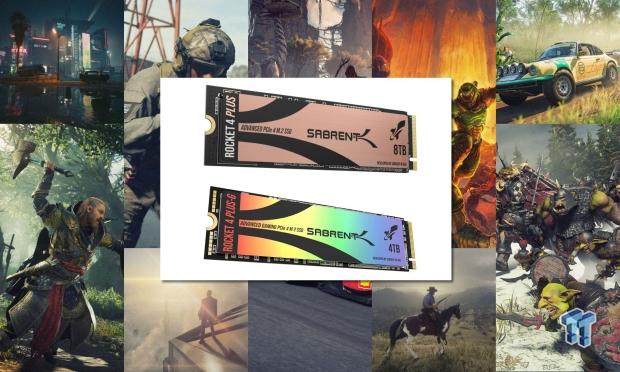
We can keep all our benchmark software installed while also installing every new game release that comes our way.
- Assassin's Creed Valhalla: Ultra High-quality settings, with the in-game benchmark tool used.
- Borderlands 3: Ultra quality settings, with the in-game benchmark tool used.
- Call of Duty: Modern Warfare II: Ultra quality setting, in-game multiplayer benchmark tool used.
- Cyberpunk 2077: Ultra quality setting, in-game benchmark tool used. AMD FSR and NVIDIA DLSS results are included.
- DOOM Eternal (RT): Ultra Nightmare quality setting with ray-tracing enabled, the opening of Mars Core campaign level used to benchmark.
- F1 22 (RT): Ultra High-quality setting with ray tracing, one lap of the Bahrain track benchmarked. AMD FSR and NVIDIA DLSS results are included.
- Forza Horizon 5 (RT): Extreme quality setting with ray tracing enabled, in-game benchmark tool used. AMD FSR and NVIDIA DLSS results are included.
- Hitman (RT): Ultra-quality settings with ray-tracing, Dubai scene benchmarked. AMD FSR and NVIDIA DLSS results are included. A May 2023 update to the game has greatly improved performance, so individual results for this game are excluded for now (but still factored into the averages).
- Horizon Zero Dawn: Ultimate quality setting, in-game benchmark used.
- Marvel's Guardians of the Galaxy (RT): Ultra quality setting with ray tracing enabled, the in-game benchmark tool used.
- Rainbow Six Extraction: Ultra quality settings and in-game benchmark tool used.
- Red Dead Redemption 2: Maximum quality settings, with in-game benchmark tool used. AMD FSR and NVIDIA DLSS results are included.
- The Division 2: Ultra quality settings with in-game benchmark tool used.
- Total War: Warhammer III: Ultra-quality settings with the in-game Battle Benchmark tool used.
14 Game Average FPS - 1080p Results
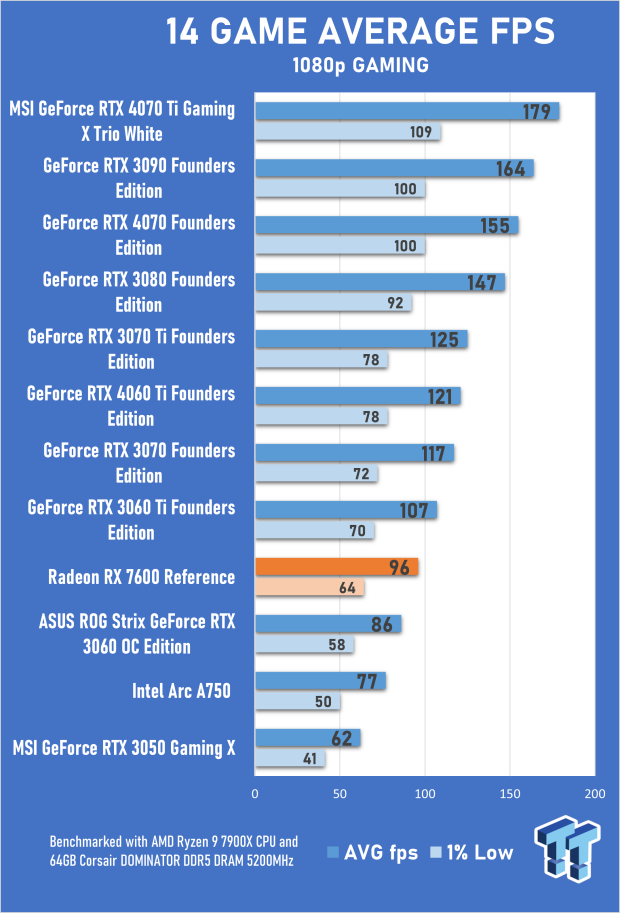
Unfortunately, we didn't have a Radeon RX 6600 on hand to take a closer look at the gen-on-gen gains for the entry-level RDNA 3 GPU, so most of the comparisons will put it up against the GeForce RTX 3060 and other RTX cards from the NVIDIA stable. The GeForce RTX 3060 comparisons are apt because it's one of the most popular GPUs in 2023, both in terms of sales and existing hardware share.
Regarding 1080p performance across all games in our testing suite, including those with ray-tracing effects, the Radeon RX 7600 slots between the RTX 3060 and the RTX 3060 Ti. This means an 11.6% improvement over GeForce RTX 3060 while falling about 10.3% short of the GeForce RTX 3060 Ti.
Of course, individual results vary from game to game, with one of the highlights for the Radeon RX 7600 being Borderlands 3, where we see performance matches the newly released GeForce RTX 4060 Ti. That said, on average, the Radeon RX 7600 is 20.7% slower than NVIDIA's new GPU.
14 Game Average FPS - 1440p Results
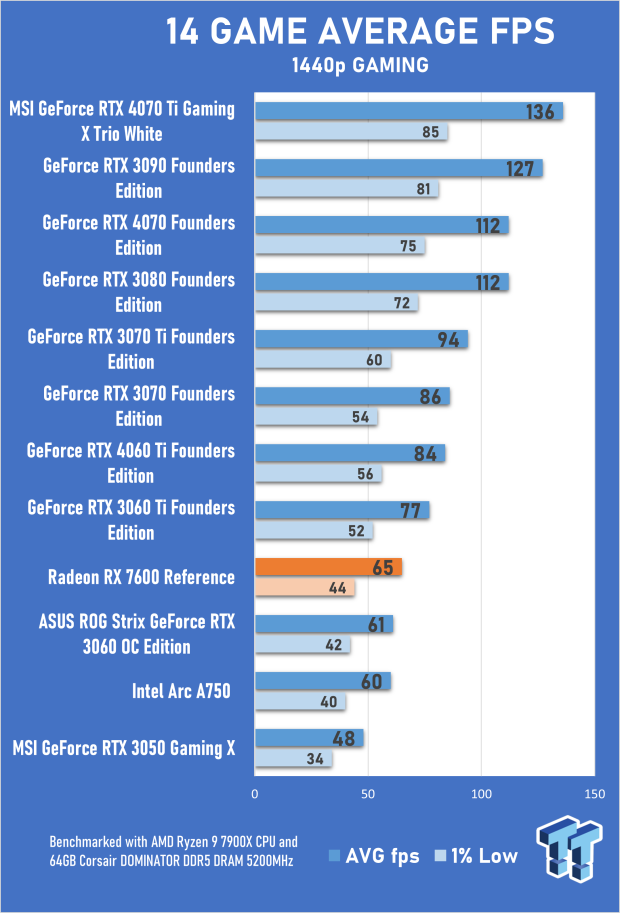
Bumping up the resolution to 1440p from 1080p and the overall performance of the Radeon RX 7600 drops by around 32% - solidifying the RDNA 3 entry-level GPU as better suited for 1080p gaming than gaming in higher resolutions. Here the performance increase over the GeForce RTX 3060 (which does feature 12GB of VRAM) drops to around 6.5%, with the gap between the Radeon RX 7600 and the GeForce RTX 3060 Ti increasing to approximately 15%.
This isn't to say that the Radeon RX 7600 isn't a 1440p-capable GPU, as it can still hit over 60 frame-per-second in several games, leading to an overall average frame rate of 65fps. Stand-out titles for the Radeon RX 7600 at this resolution include Call of Duty: Modern Warfare II, Assassin's Creed Valhalla, and Borderlands 3. At 1440p, though, the Radeon RX 7600 does struggle with ray-tracing, with performance sitting much closer to the GeForce RTX 3060.
Benchmarks - 3DMark FireStrike
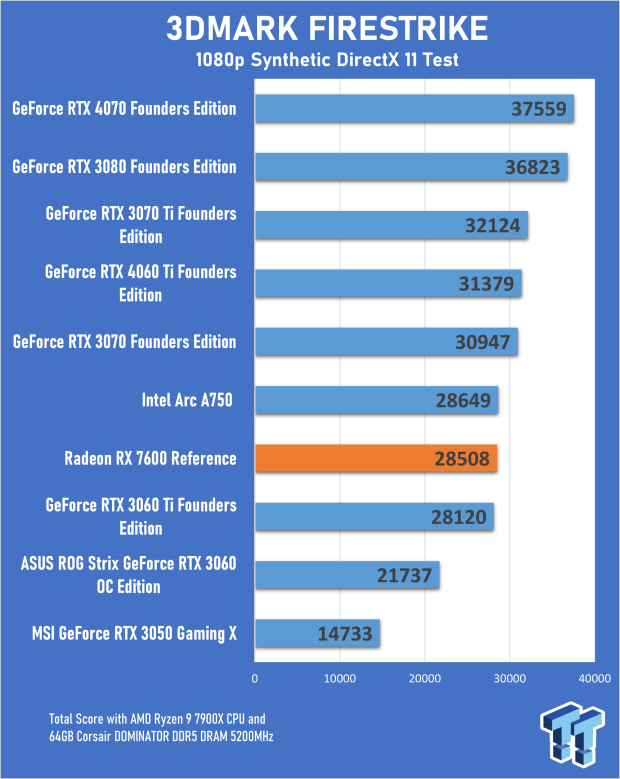
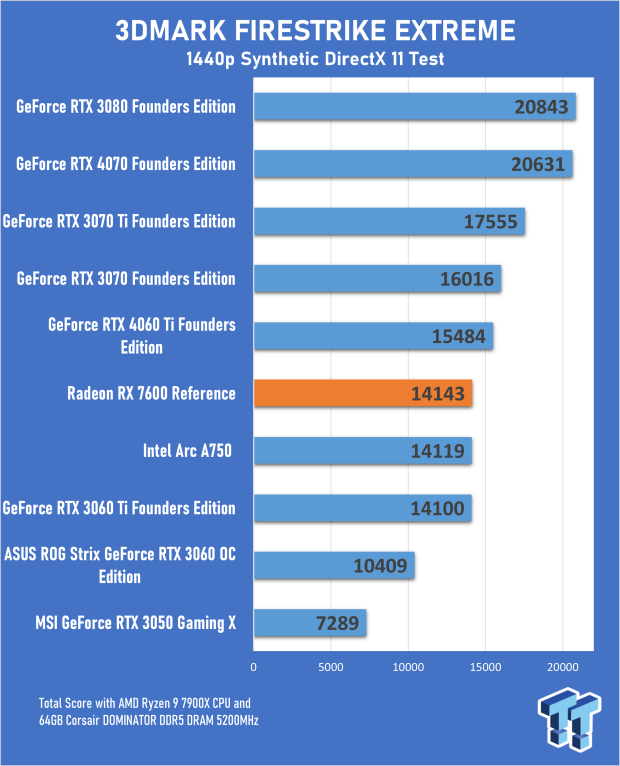
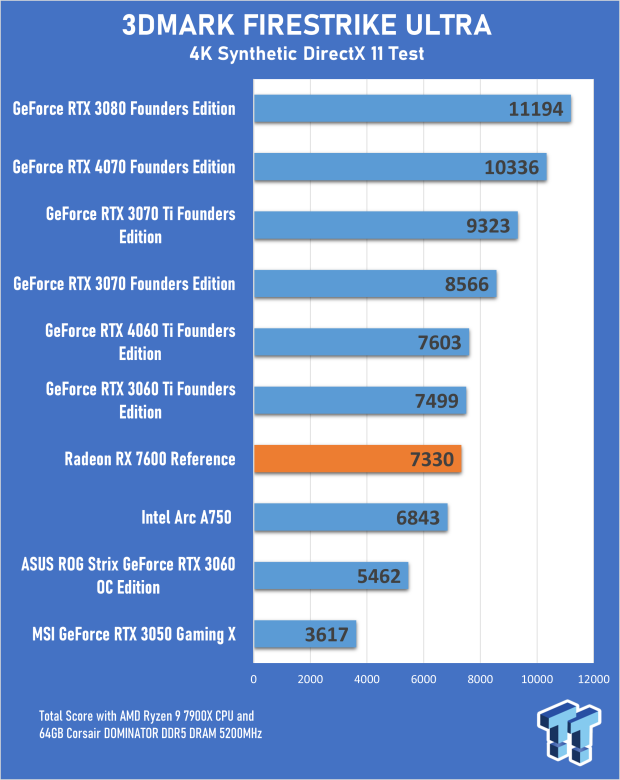
3DMark FireStrike is a DirectX 11 test that has been around for many years and covers quite a large portion of games released over the past decade - at least in terms of the API and graphics technologies used. The three tests cover the resolutions - 1080p, 1440p, and 4K. The 1080p and 1440p tests show that the Radeon RX 7600 slightly edges out the GeForce RTX 3060 Ti, scoring over 30% higher than the baseline GeForce RTX 3060.
As a synthetic benchmark, this result doesn't translate to our real-world in-game numbers but could indicate more work to be done on the driver side by AMD in the coming months-something to consider.
Benchmarks - 3DMark TimeSpy and Port Royal
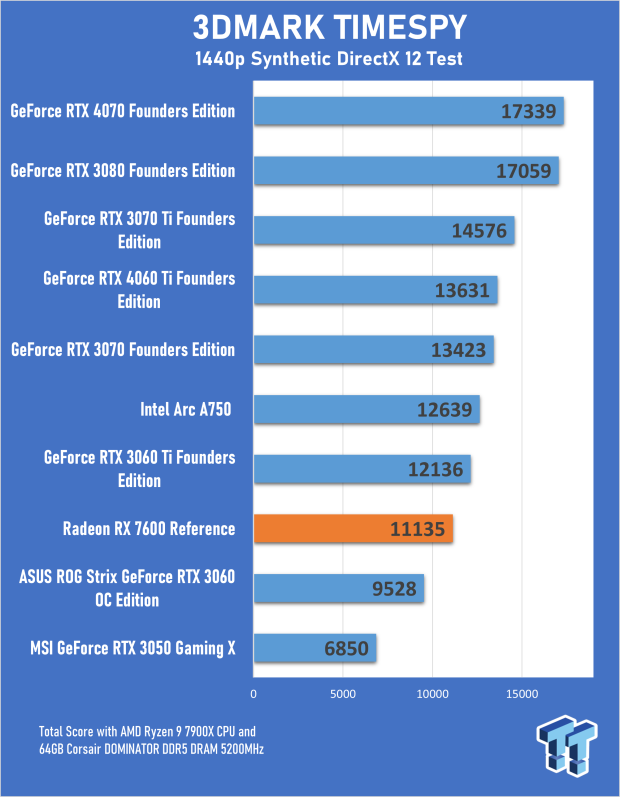
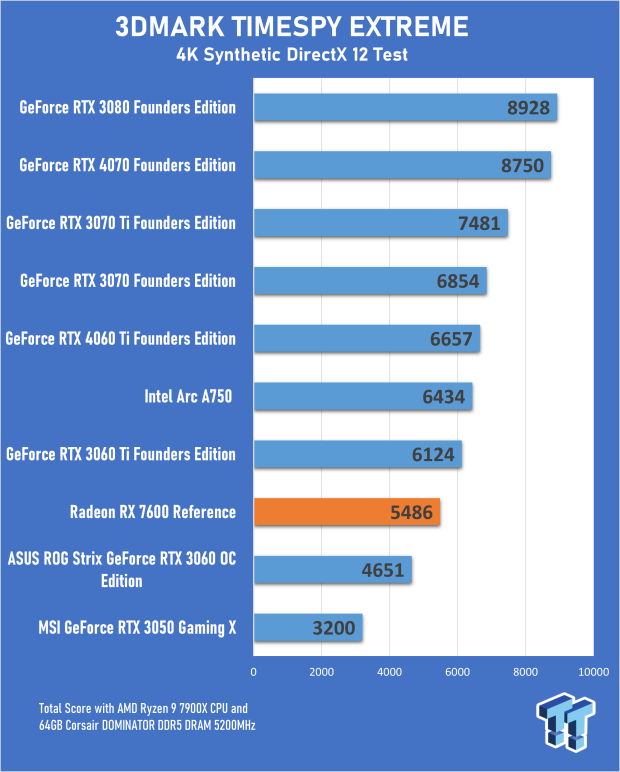
With 3DMark TimeSpy being DirectX 12-based, it's a more relevant synthetic benchmark for modern games. And here, we see results that more closely match the in-game benchmarks, with the Radeon RX 7600's 1440p score sitting between the RTX 3060 and RTX 3060 Ti. The overall score is 16.8% higher than the GeForce RTX 3060 and 8.2% lower than the GeForce RTX 3060 Ti. It's a similar result for the 4K test. However, the Radeon RX 7600 is not something you'd consider 4K-ready unless you're playing a game with low to medium visual settings.
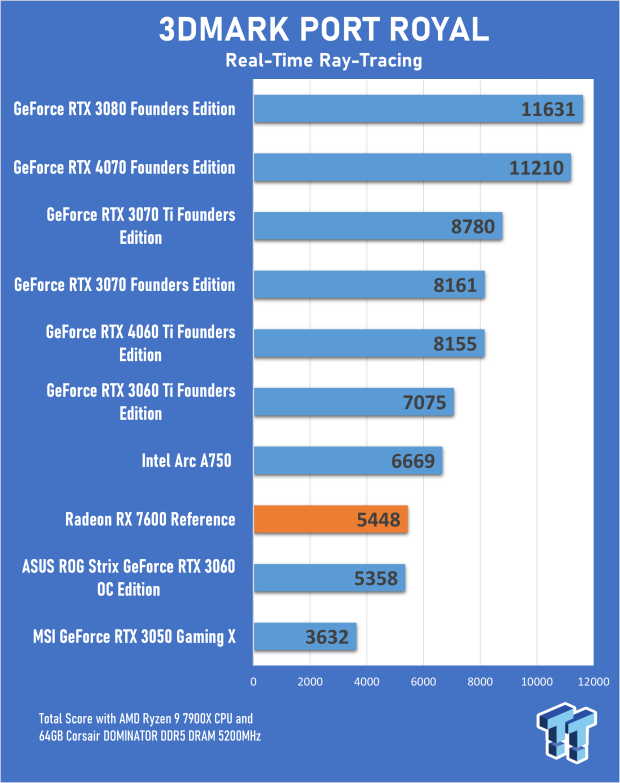
3DMark Port Royal is a synthetic ray-tracing benchmark, and here, the entry-level Radeon RX 7600 struggles a bit with a score that matches the GeForce RTX 3060. This doesn't mean the GPU can't handle ray tracing, but you can expect a pretty sizable drop in performance when enabling the hardware-intensive effect.
Case in point, even though DOOM Eternal and its Vulkan API favors RTX hardware, with RT effects enabled, performance on the Radeon RX 7600 takes a massive hit at both 1080p and 1440p - to the point where it falls behind the GeForce RTX 3060 by a considerable margin. That said, ray tracing performance in games like Forza Horizon 5 and F1 22 does beat out the GeForce RTX 3060 by a small percentage - which is great to see.
Benchmarks - 1080p Gaming
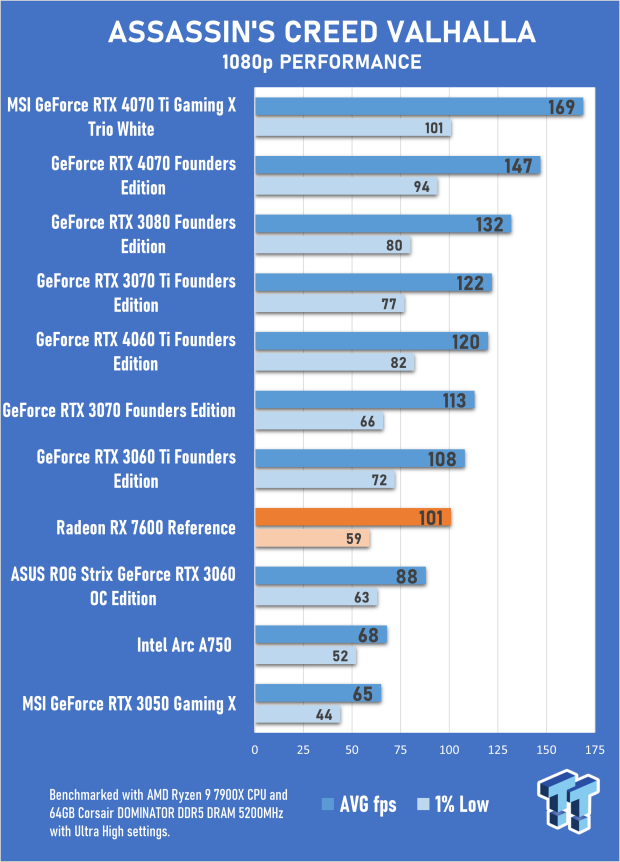
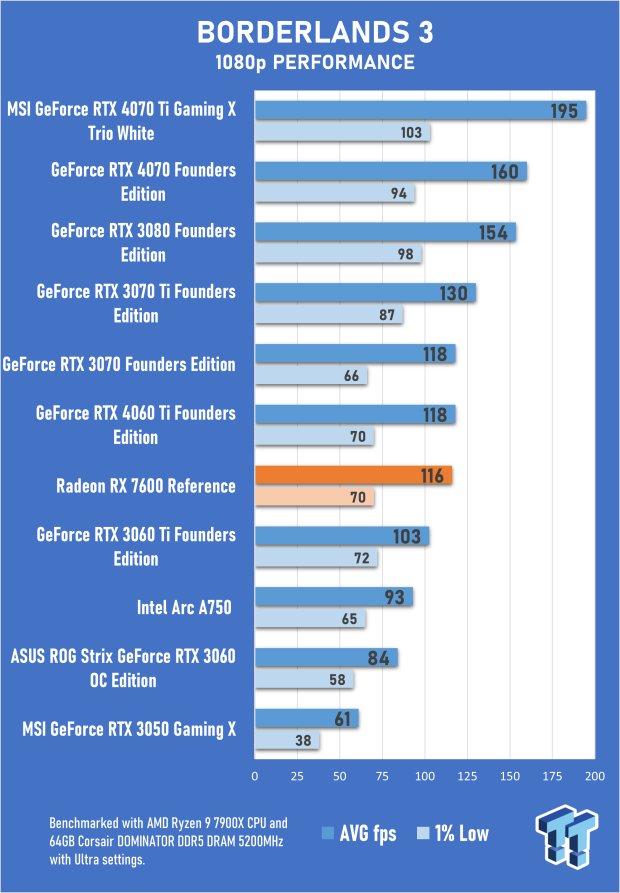
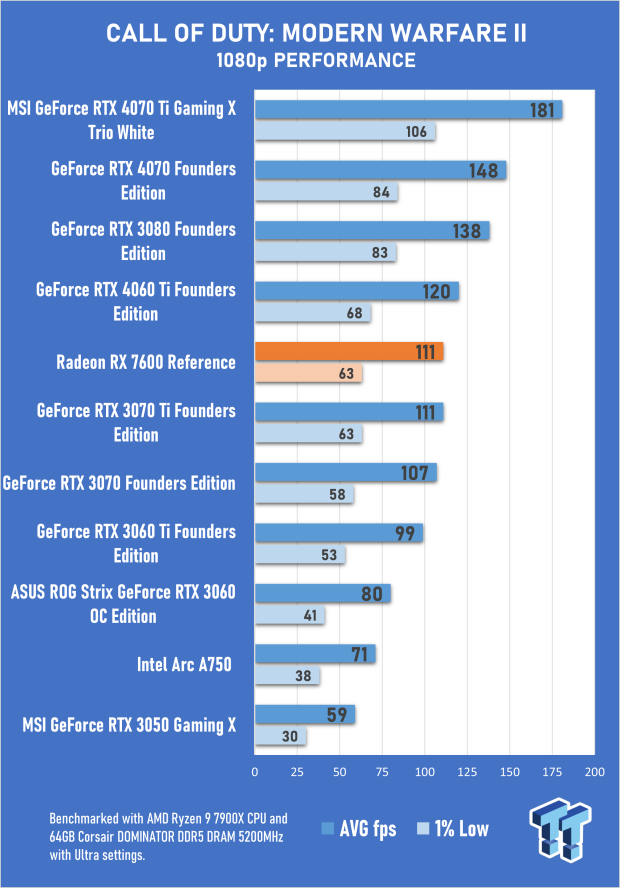
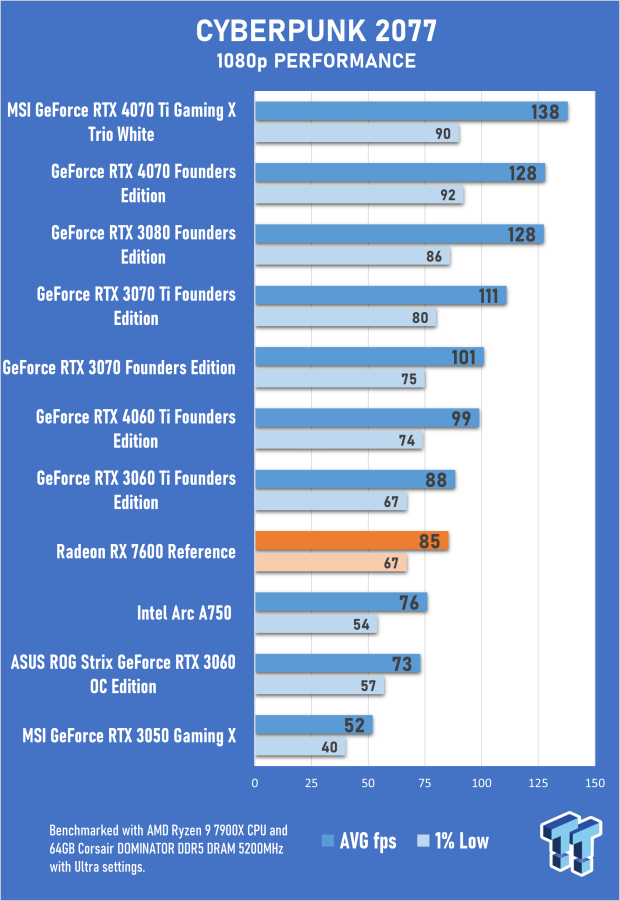
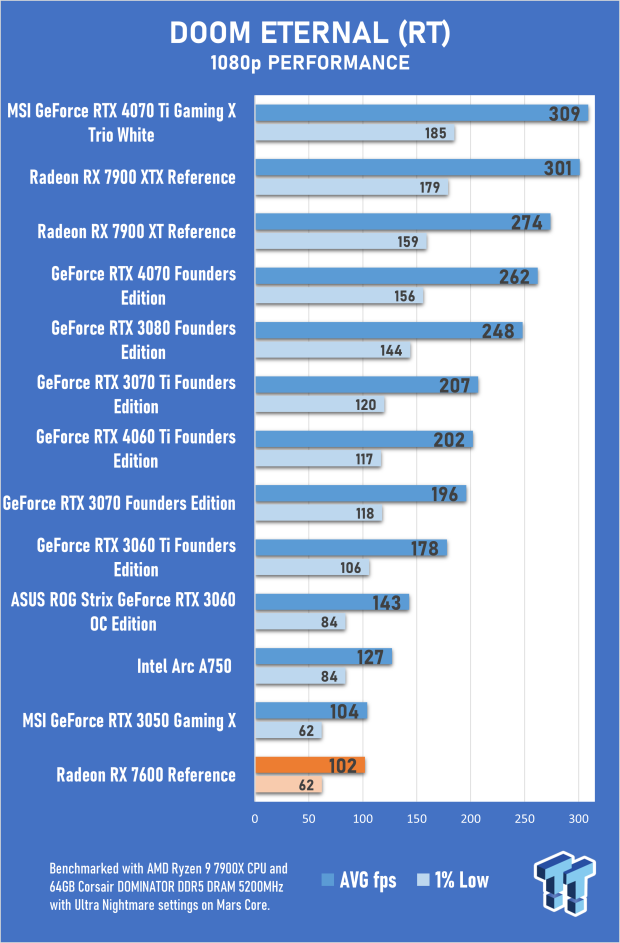
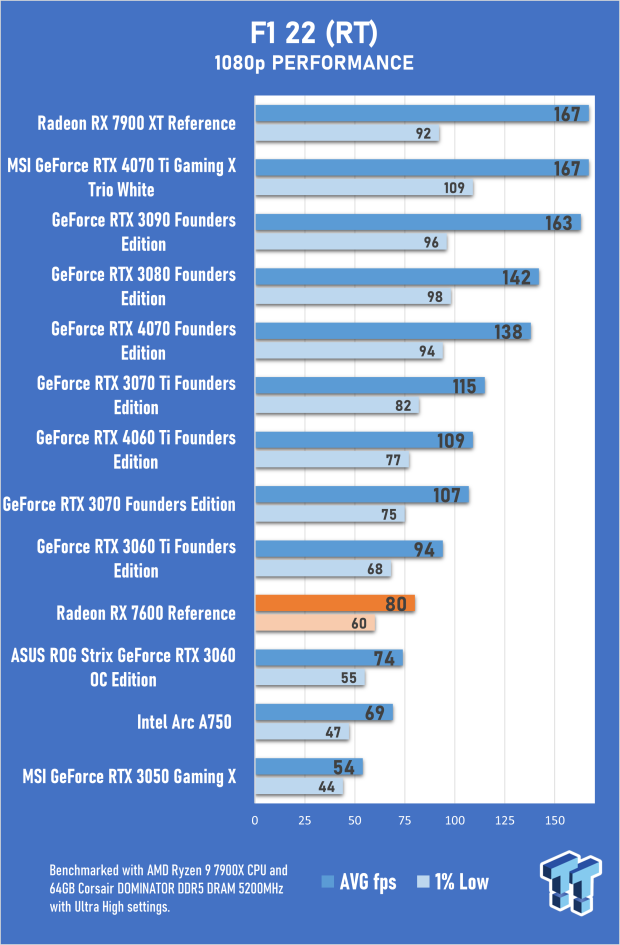
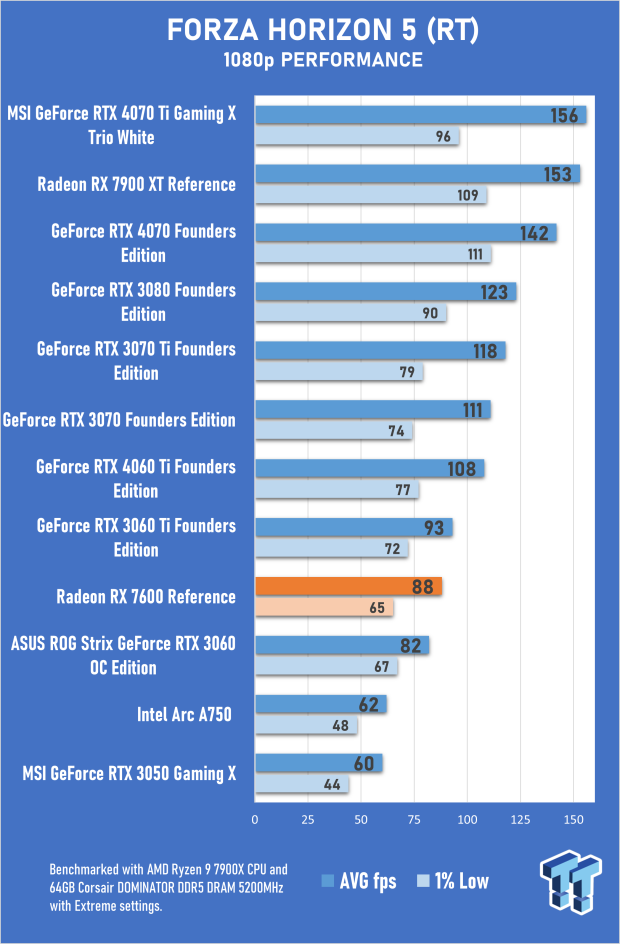
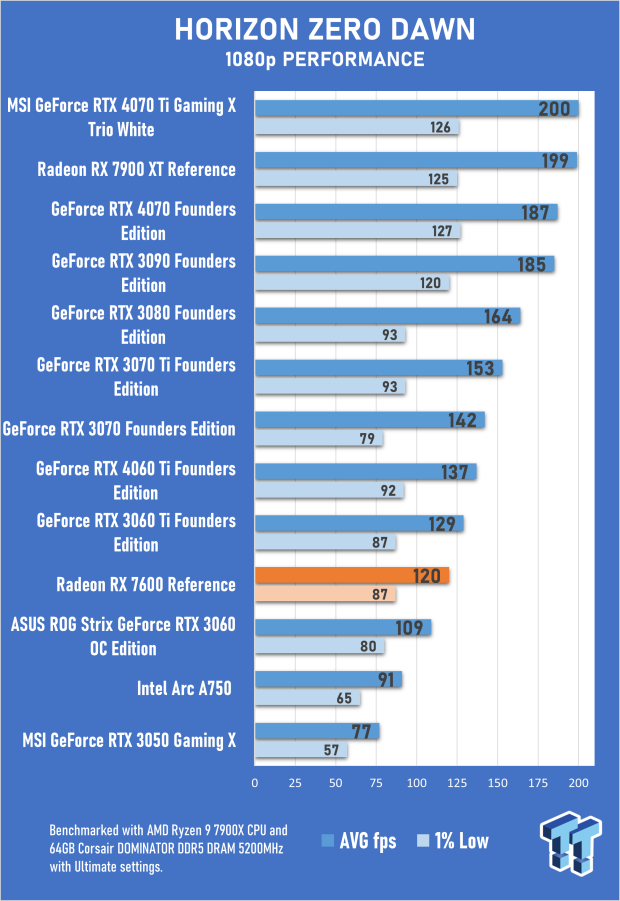
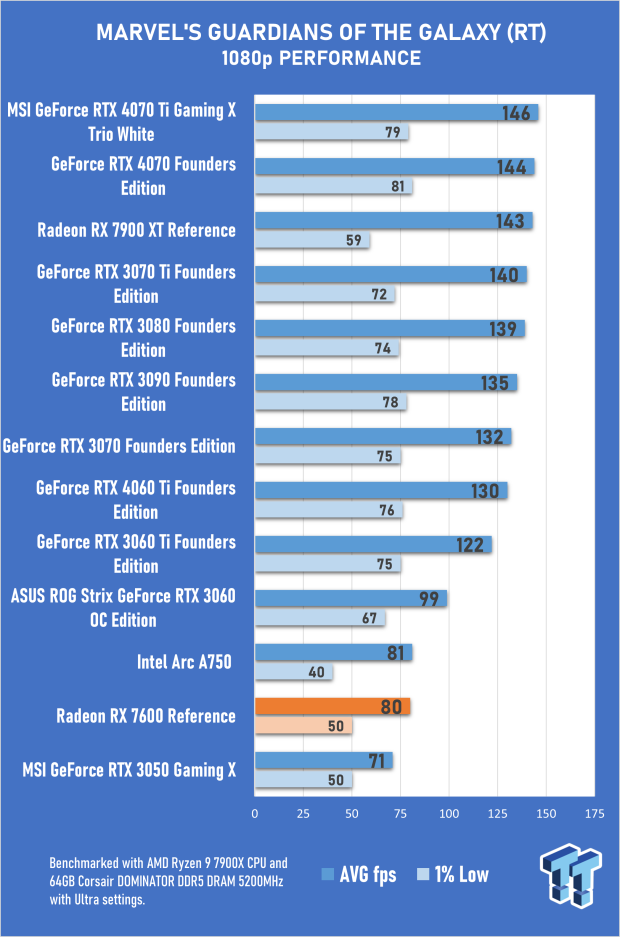
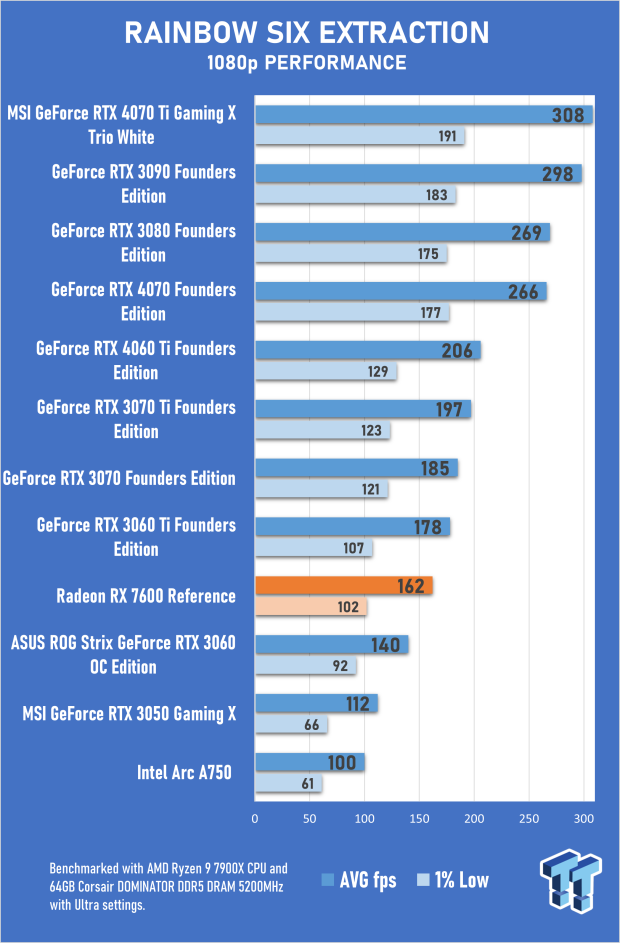
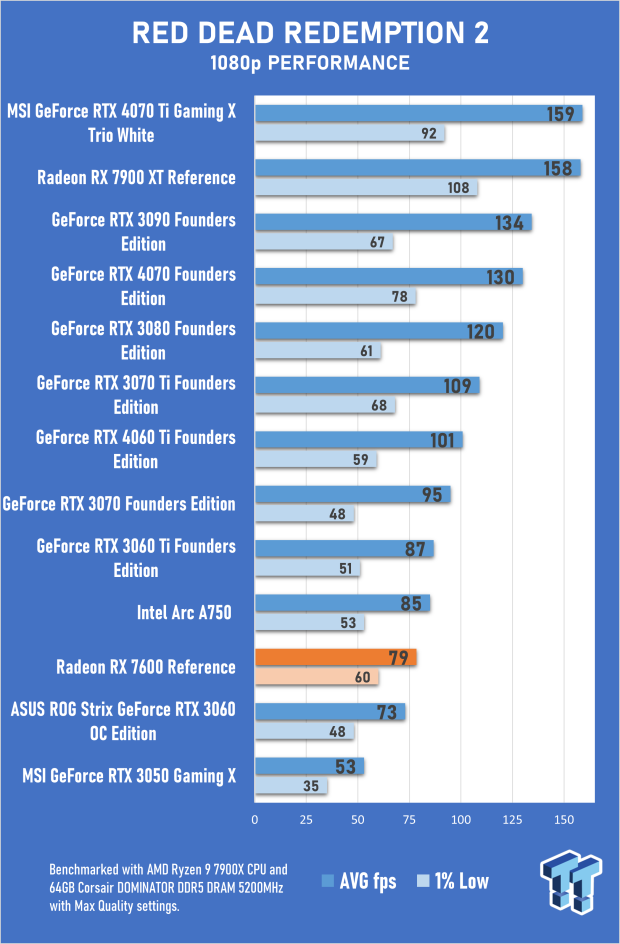
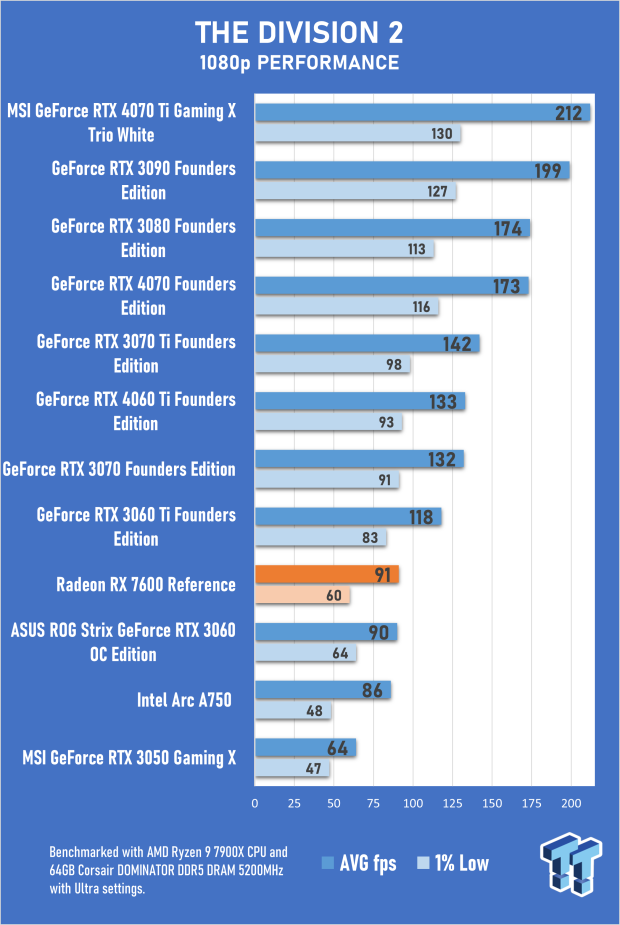
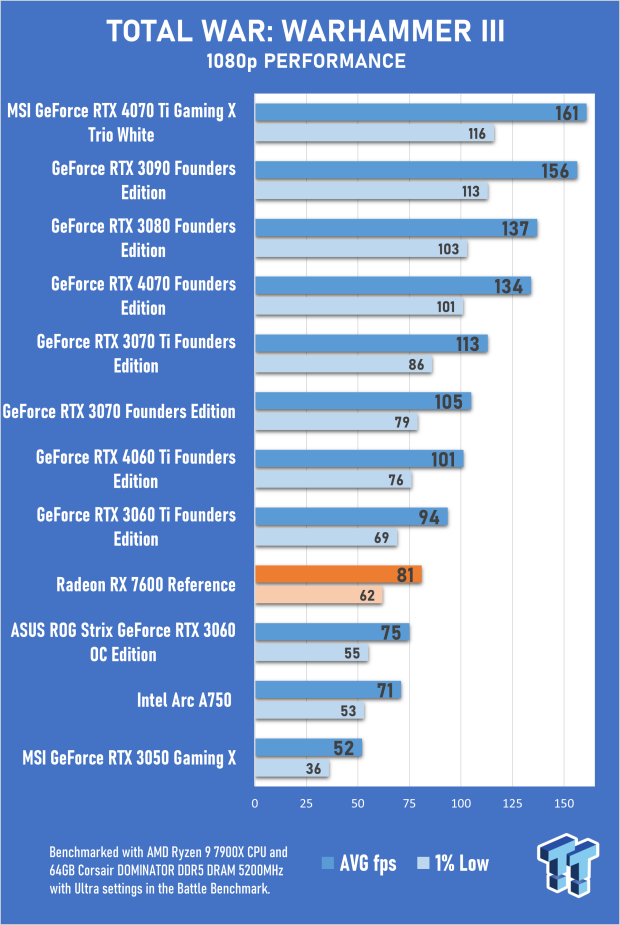
Benchmarks - 1440p Gaming
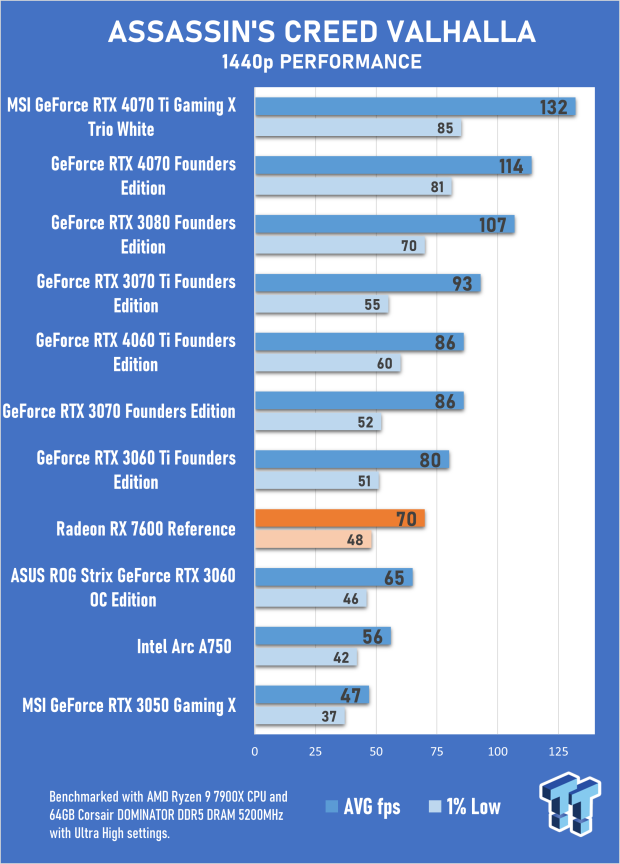
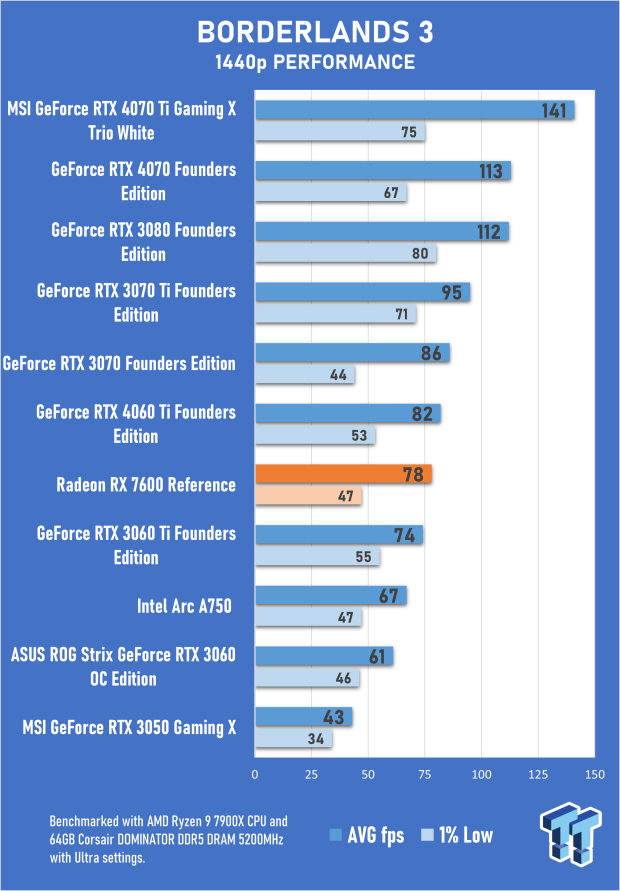
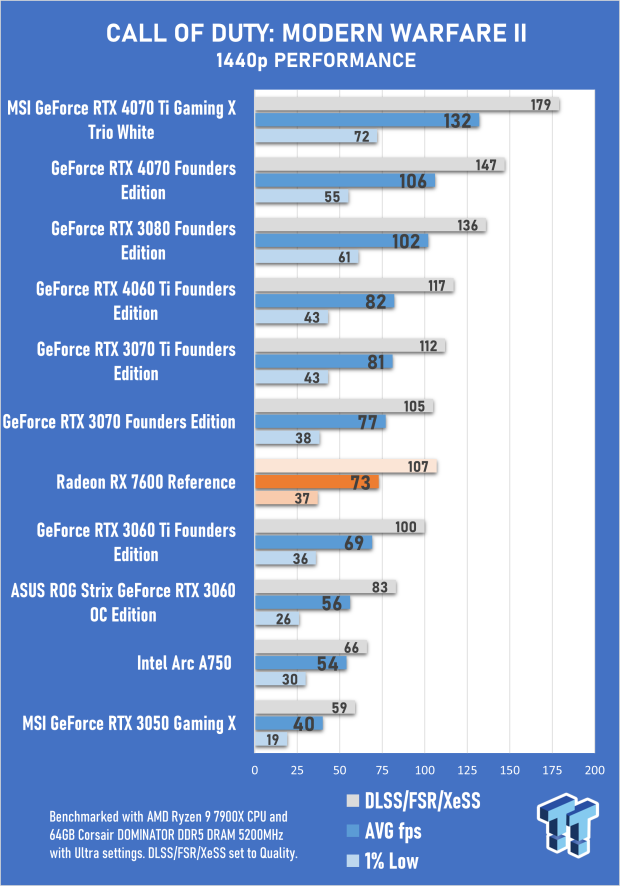
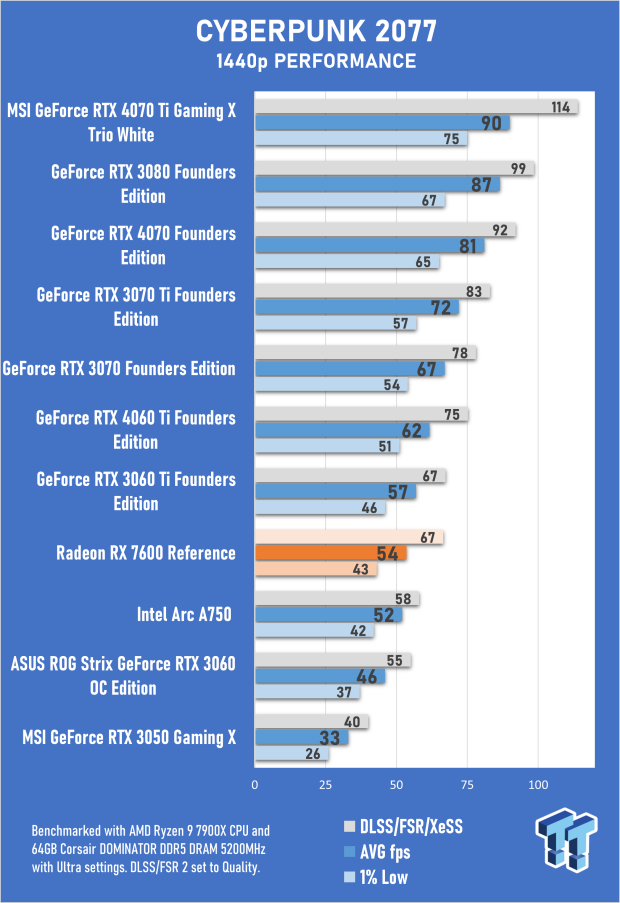
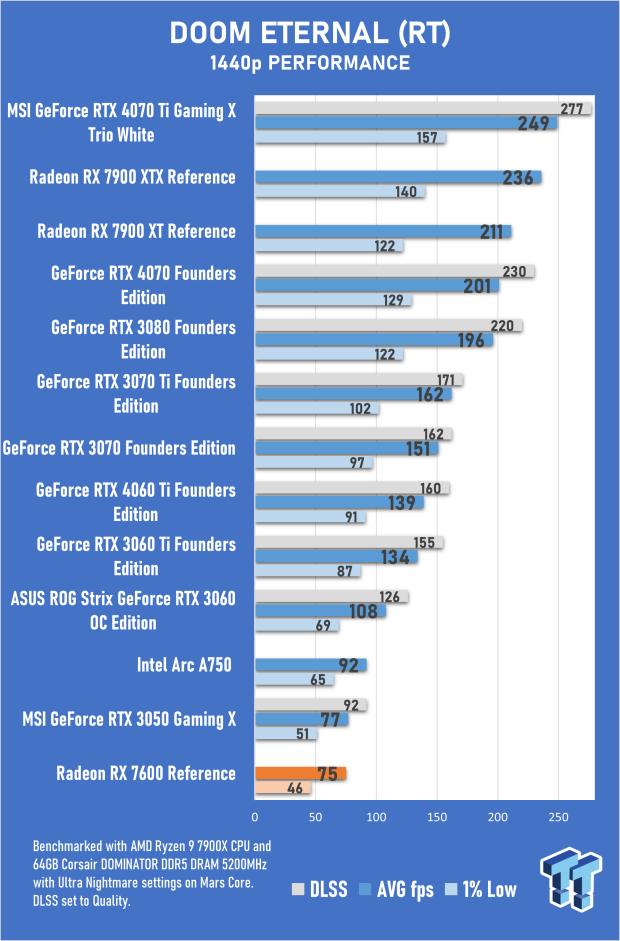
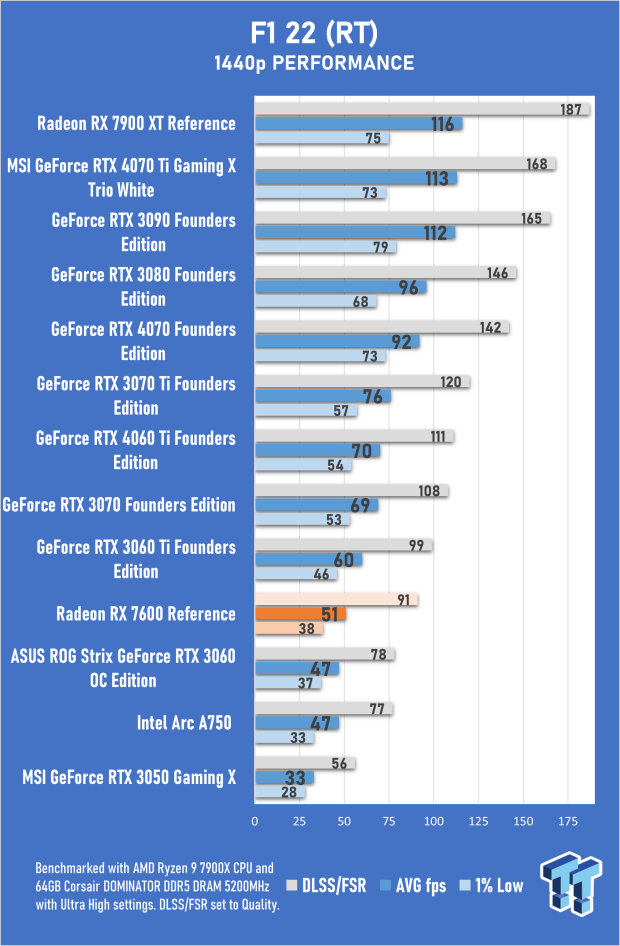
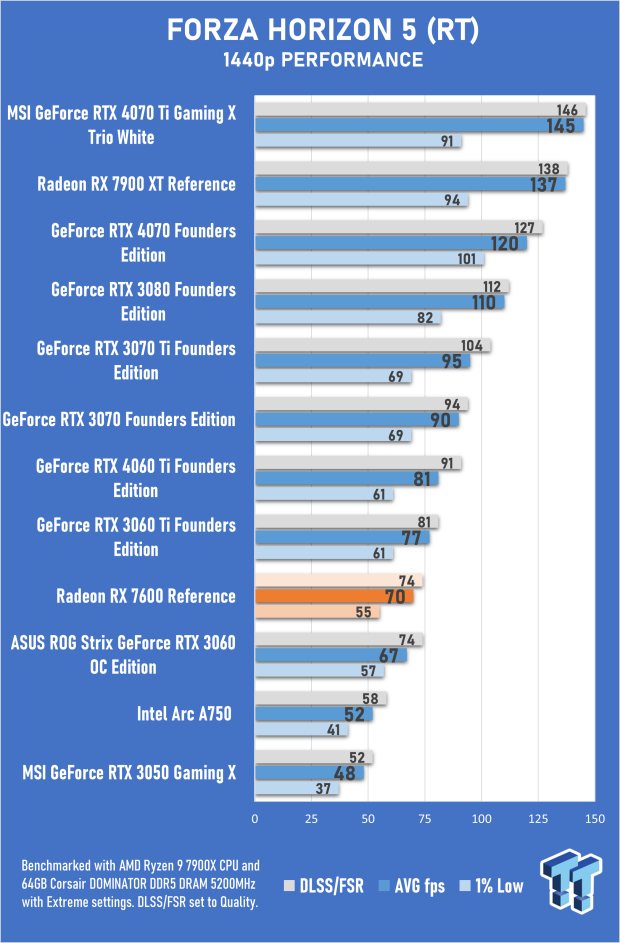
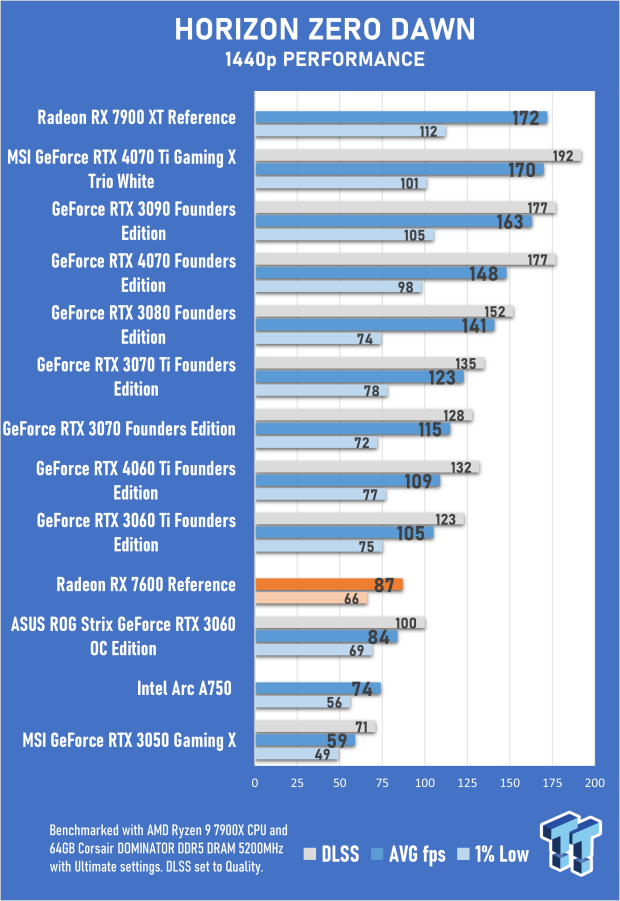
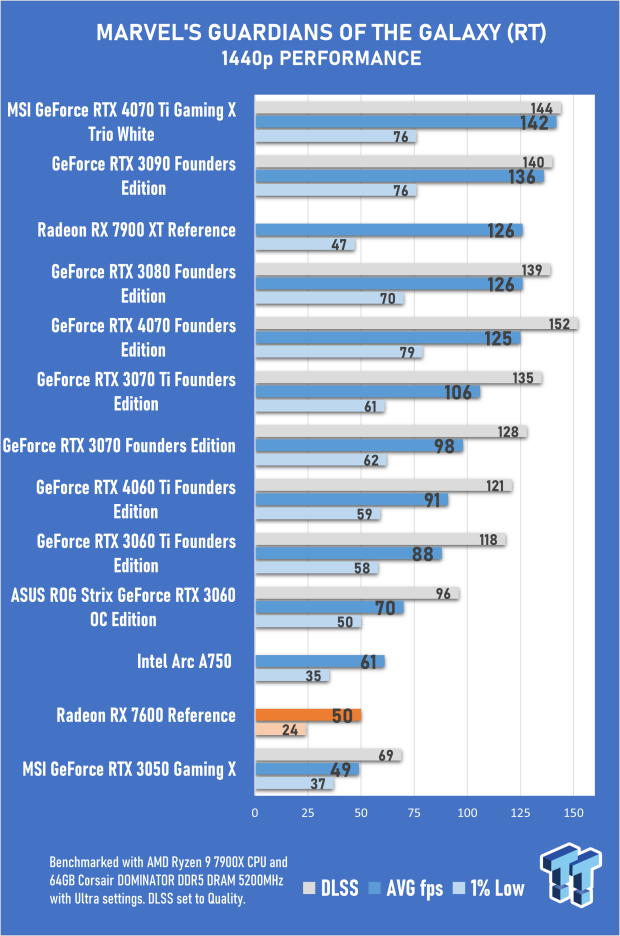
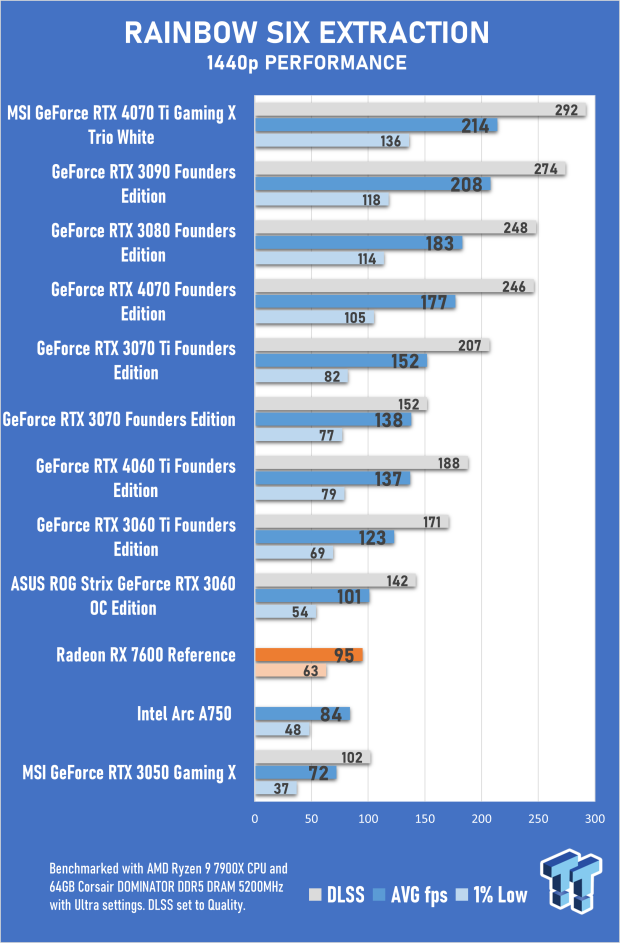
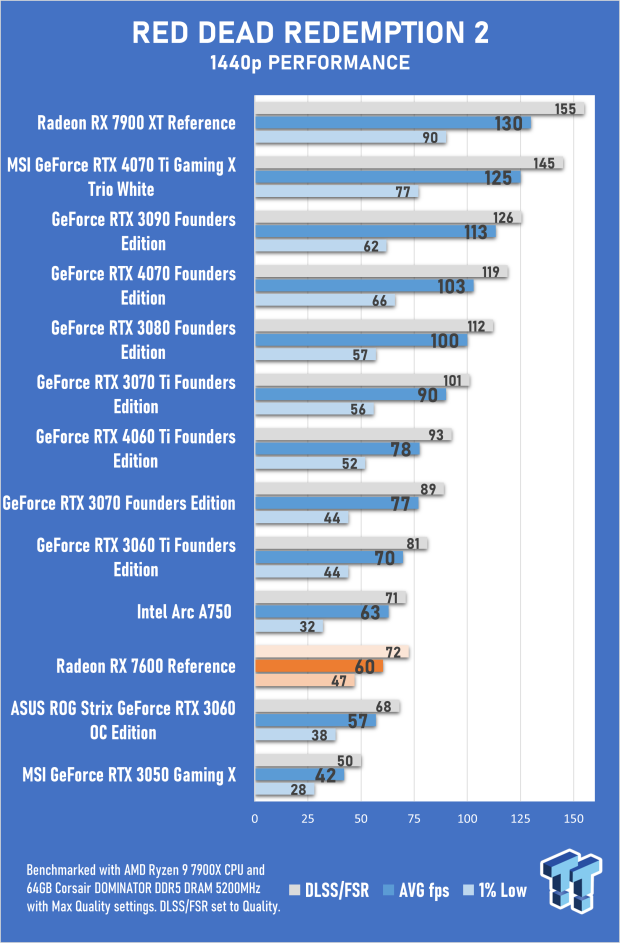
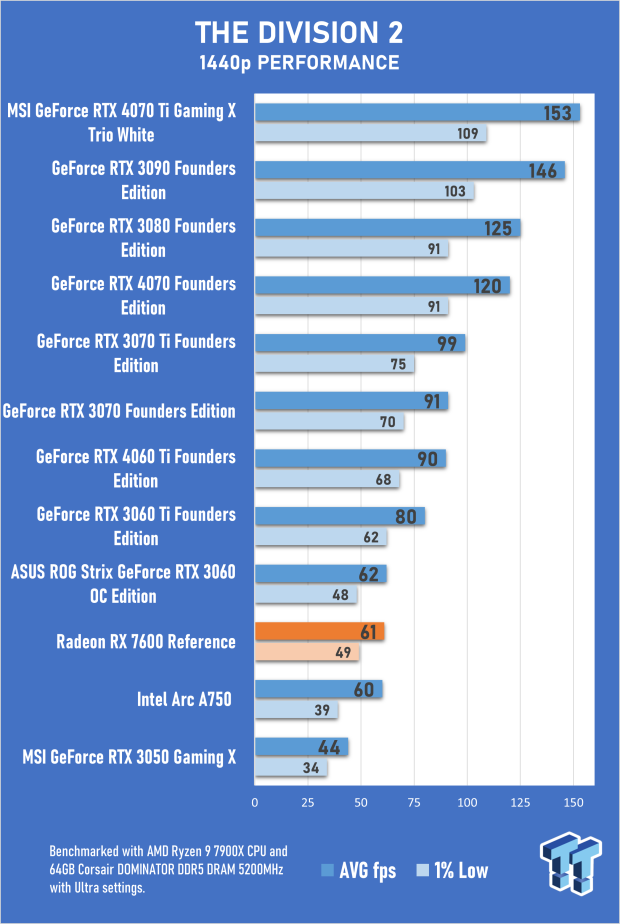
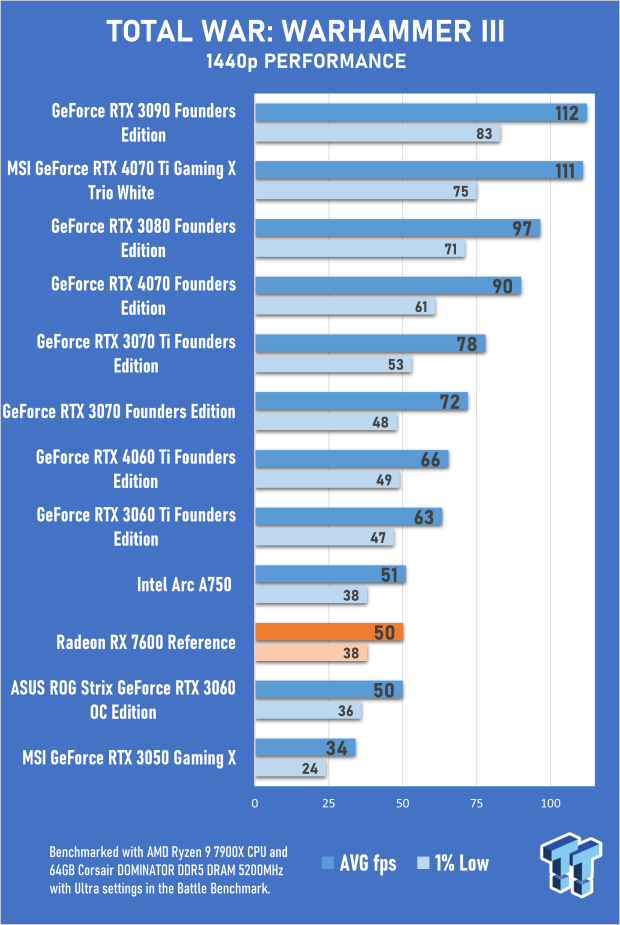
Benchmarks Summary, Ray-Tracing Performance, and FSR 2
Across all games tested, it's clear that the Radeon RX 7600 is a card for 1080p gaming, delivering an uplift over the GeForce RTX 3060 with a price point that is far more attractive to consumers. For the most part, performance sits in between the RTX 3060 and RTX 3060 Ti, with a few exceptions.
On the plus side, popular modern games like Call of Duty: Modern Warfare II run great on AMD's RDNA 3 architecture, with the results for the Radeon RX 7600 matching the GeForce RTX 3070 Ti - a great showing. And then there's the 1% low performance, bolstered by AMD Infinity Cache, that sees Cyberpunk 2077 hit an average of 85fps in 1080p with a 1% low of 67fps.
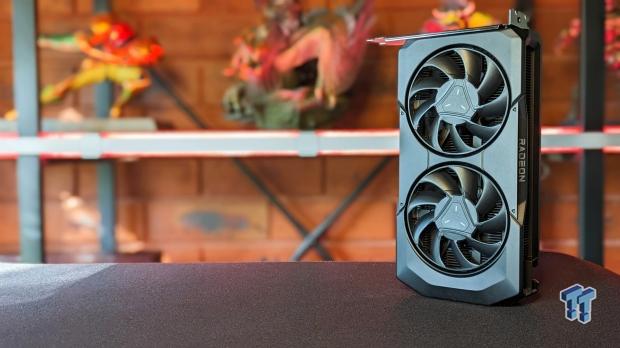
As mentioned a few times already, ray-tracing performance looks to be the Achilles heel of the Radeon RX 7600, where, at best, you're looking at an RTX 3060-like version and, at worse, something closer to the GeForce RTX 3050. It's still playable for the most part, but when you can get a massive boost to performance by turning off RT effects, the trade-off might not be worth it.
AMD's FSR 2 tech is impressive, offering a boost to performance though enabling it at 1080p does impact visual quality in a way you don't see with NVIDIA's DLSS. Enabling this at 1440p using the highest-quality preset can deliver some impressive gains - F1 22 goes from 51fps to 91fps, and Call of Duty: Modern Warfare II goes from 73fps to 107fps - but even here, the technology doesn't quite match the visual fidelity of DLSS.
Temperature and Power Efficiency
Comparing the power draw of the Radeon RX 7600 to the previous generation's Radeon RX 6600 and the jump to 165W from 132W results in 25% more power usage when gaming gen-on-gen. This is disappointing as it highlights that RDNA 3 hasn't hit AMD's efficiency targets for this new generation of GPUs from Team Red. You're still looking at a single 8-pin power connector and a small form factor, and 165W is still on the low end, so it's not something you'll likely notice.
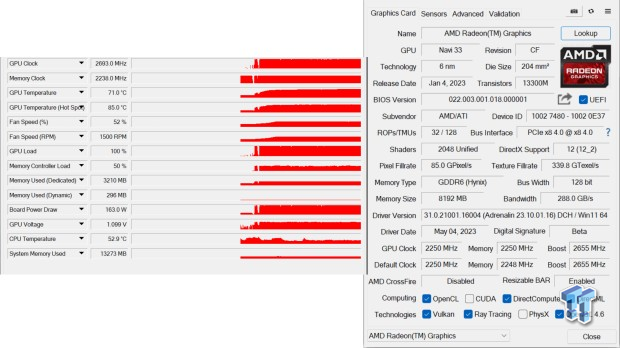
Regarding the reference Radeon RX 7600, cooling is a step behind what we've been seeing with NVIDIA's Ada Lovelace generation. Here temperatures quickly climb to above 70 degrees Celsius with a hot spot of 85 degrees under full load. This is within AMD's targets, with the review guide noting that the Radeon RX 7600 has been designed to run, well, warmer. The downside is that fan speeds generally exceed 50% in addition to noticeable coil whine, so it's not a quiet GPU. Small, yes, but audible when in use.
Final Thoughts
The budget GPU space is highly competitive, with options from AMD, Intel, and NVIDIA all vying for attention. The Radeon RX 7600's main draw-card, outside of solid 1080p performance, is its price point of USD 269. And really, that makes it a product not as exciting as something that could cause a massive shake-up to how we look at entry-level and mainstream GPU performance. Better than GeForce RTX 3060 performance is excellent for the Radeon RX 7600. Still, we can only imagine the reception if it somehow managed to get within striking distance of NVIDIA's new GeForce RTX 4060 Ti.
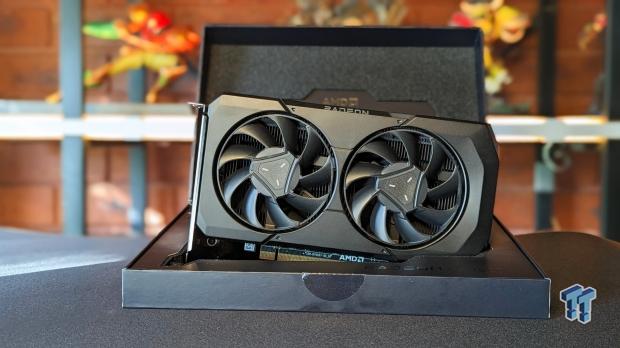
As a brand-new GPU offering, the Radeon RX 7600 is an affordable alternative to the GeForce RTX 3060 for 1080p gaming. The reference model reviewed here features a robust build and is tiny to boot, but if we had to choose, we'd prefer Sapphire's Pulse model, which we're currently reviewing. It's quieter, runs cooler, and is still a compact two-slot GPU.
In the end, if you're putting together a new budget gaming PC with 1080p performance in mind playing competitive titles and current releases, then the Radeon RX 7600 is a great choice. The price is right, and it outperforms the popular GeForce RTX 3060 - though not by an amount that feels truly exciting.

